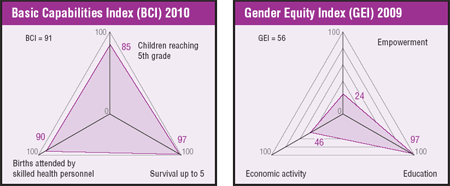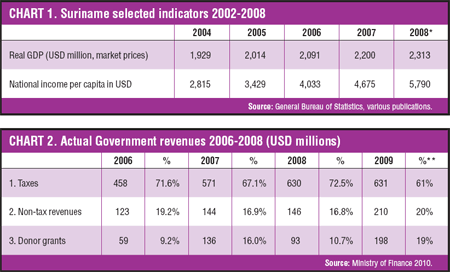Big challenges ahead
Institute for Public Finance
Drs. Satja Jabar
The country is heavily dependent on foreign development assistance through either bilateral aid relations or multilateral financing institutions. Although there has been economic growth in the past decade, this has had adverse development effects by widening inequalities in an already vulnerable society. With over 60% of the population living below the poverty line, the country faces many social problems including in housing, access to health, education and gender equality. Finding a balance between ethnic group interests and those of the nation at large is a pre-requisite for sustainable growth and development.
 |
Suriname, a small economy with a population of 517,052 inhabitants and a land area of 164,000 km2,[1] has had a dual production structure since colonial times: low-value agricultural products and raw materials produced by local businesses on the one hand; and high-value products from the mining industry, such as bauxite, gold and recently oil, generated by foreign multinationals on the other. The Government thus has little influence over about 85% of exports earnings. Oil has been and still is the only national success story, although telecommunications and tourism have recently been contributing an increasing share to the national income.
Since independence in 1975, millions US dollars have been received or borrowed through either bilateral aid relations or multilateral financing institutions such as the Inter-American Development Bank (IDB). For instance, Dutch assistance to Suriname has amounted to about USD 100 million per year since independence, except during periods of military rule; and total European Commission (EC) assistance since 1975 is estimated at EUR 165 million (USD 203 million). This money, combined with national budget expenditures, resulted in intensive economic growth in the past five years.
 |
This growth has had adverse development effects, however, in terms of widening income inequalities within an already vulnerable society. Suriname is ranked 97 out of 182 countries in the 2009 UNDP Human Development Index (HDI), with an HDI value of 0.769. It is ranked 46 out of 135 countries in the Human Poverty Index, with a value of 10.1%. Its Millennium Development Goals (MDGs) baseline report for 2005 indicates that in 1999-2000 over 60% of the population lived below the poverty line.[2]
The Government employs around 40% of the workforce, making it the largest employer in the country. This puts an enormous pressure on its finances as an average of 80% of recurrent costs are made up of wages and salaries, leaving little room for other expenditures such as telecommunications, training and transportation.[3] There is a historical heritage of the State appointing civil servants in order to establish legitimacy and power and restructuring the Government has been a policy priority for decades. The private sector in general is weak and small; 90% consists of small family businesses employing 1-10 persons.[4]
Social challenges everywhere
Suriname faces many social problems. One of these is unequal access to education, especially in the poorer areas. The poor quality of teachers, schools and learning aids do not help counter the inefficiency of the primary education system, where more than 40% of the students take seven years or more to finish the six-year course and only 50% pass the final exam. This occurs in spite of about 6.5% of Gross Domestic Product (GDP) and 15% of the Government’s recurrent expenditure being spent on education.[5] The causes of this inefficiency include shortages in quality learning aids, obsolete curricula, insufficient training and re-training of teachers, insufficiently competent teachers and poor testing and selection systems.[6]
The health sector in Suriname is currently facing serious obstacles. About 35% of the population does not have health insurance or coverage.[7] This led the Ministry of Health to design a general health insurance scheme, which is still under discussion. There is also inequitable access to water and sanitation services. Mercury pollution from small-scale gold mining activities in the interior, excessive pesticide use on agricultural lands in rural coastal areas and the widespread practice of dumping sewage into street ditches and canals, all pose a serious threat to the quality of drinking water.
Housing is another big challenge. Some housing situations are comparable to bidonvilles (settlements)in Latin America with people living in illegal dwellings on land they do not own. There are no running water, sanitary or electricity services in these areas and the lack of employment opportunities results in high crime rates. Estimates for 2008 indicate a housing deficit of 30,000 houses in an estimated total number of 120,000 households nationally.[8] This means that 25% of households lack proper housing facilities.
Dependence on external development aid
The IDB runs two loan programs in the country (20% loans, 80% grants) for increasing the housing supply. Within the first program, the Low Income Shelter Program (LISP), about 1,155 new houses and 2,512 renovations were financed, including a subsidy for the borrowers. This program favoured women since about 60% of households in Paramaribo, the capital city, are female-headed.[9] A constraining factor, however, was that many people lacked title to the land on which new houses were to be built. The IDB also has a long-term program with the Government for improving education.
The most important donor country, the Netherlands, financed a program for micro-credit lending. This aims to stimulate micro-entrepreneurship and encourages women to apply. More than EUR 100 million (USD 123 million) are also invested in physical infrastructure such as road improvement, education, strengthening of entrepreneurship, land information and registration.
As shown below, donor grants were expected to play an important role (19%) in total government revenue in 2009. Suriname’s 2006-2011 Multi-Year Development Plan assumes that 50% of its financing will come from Foreign Direct Investment (FDI).[10] However, domestic revenues must improve for independent development and growth to take place. The tax base has to be broadened – by introducing property taxes, for instance, which has not been done for political reasons.
Gender equality
Gender equality needs more attention from the Government and there is no national gender action policy. In a statement before the UN Commission on the Status of Women, the Minister of Home Affairs, Maurits Hassankhan, acknowledged that many challenges remain in the promotion of gender equality and the empowerment of women: “Besides insufficient financial resources, we also face challenges in lack of capacity with government officials and civil society, including NGOs. The lack of sex-disaggregated data and analysis constrains the formulation and implementation of policies geared towards improving the situation and rights of women and moreover constrains our capacity to measure progress in allocating domestic resources.” [11]
Challenges ahead
Suriname faces four important challenges. The first is its dependence on donor finances for development projects, since official development assistance is not going to be there for ever. The second is that around 80% of export earnings are derived from mining products (oil, gold and bauxite and alumina), which are non-renewable resources. Planning for the future will have to incorporate developing products that are sustainable.
The third challenge is Institutional strengthening. Many institutions within the Government are historically weak or non-existent. Pressured by international relations, multilateral institutions like the IMF and the IDB and its largest donor, the Netherlands, Suriname was forced into the adoption of the “free-market” approach to growth and development. This requires the establishment of many mechanisms and institutions for market creation and supervision, regulation, information dissemination, dispute settlement, regulation of competition and the like that are currently either not in place or very weak.
Finally, the fourth challenge is finding a balance between ethnic group interests and those of the nation at large. With few exceptions, political parties have been based on ethnicity for a long time and politics has been used to provide members of the particular ethnic group with jobs, income, land, government health care cards and access to other production factors. This ethnic competition gets in the way of efficient and effective Government management and governance.
[2] Government of Suriname and UN Country Team, Suriname MDG Baseline Report 2005. Available from: <www.undg.org/archive_docs/6945-Suriname_MDG_Baseline_Report.pdf>.
[3] Ministry of Finance, Financiele Notas, various years.
[4] Iwan Poerschke, “Quick Scan of Small Entrepreneurs in Suriname,” December 2009.
[5] Ministry of Finance, Central Bookkeeping Office, various budget reports.
[6] VVOB Education for Development, “Suriname: Building the Ship of Educational Reform.” Available from: <www.vvob.be/vvob/files/annual_report_vvob_2008_LR_only_suriname.pdf>.
[7] Pan American Health Organization (PAHO), Health in the Americas 2007, Volume II–countries, Washington, DC, 2007.
[8] Felipe Morris, “Suriname Housing Market Study,” IDB, August 2008, 14.
[9] General Bureau of Statistics, Household Budget Surveys.
[10] US Department of State, “2009 Investment Climate Statement – Suriname.” Available from: <www.state.gov/e/eeb/rls/othr/ics/2009/117147.htm>.
[11] New York, 27 February 2008.


